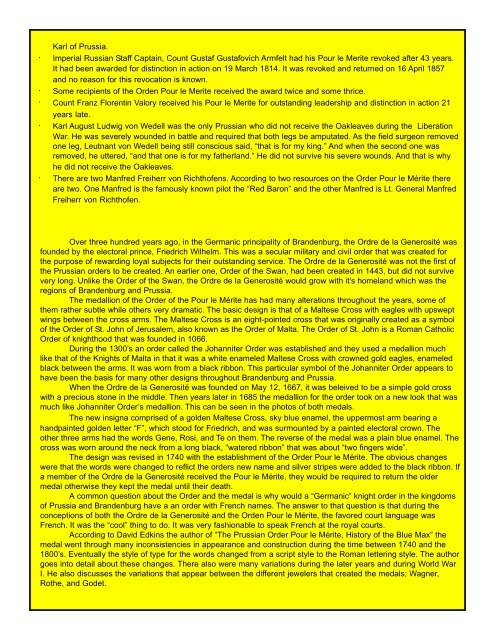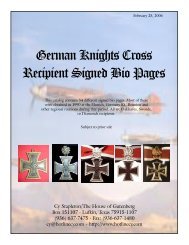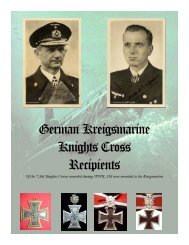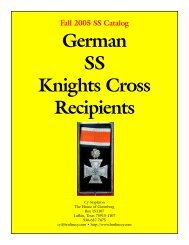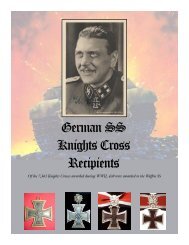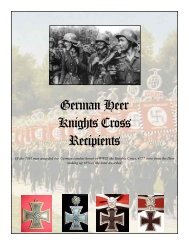Recipients of the Blue Max were required to wear the badge, which ...
Recipients of the Blue Max were required to wear the badge, which ...
Recipients of the Blue Max were required to wear the badge, which ...
Create successful ePaper yourself
Turn your PDF publications into a flip-book with our unique Google optimized e-Paper software.
Karl <strong>of</strong> Prussia.<br />
· Imperial Russian Staff Captain, Count Gustaf Gustafovich Armfelt had his Pour le Merite revoked after 43 years.<br />
It had been awarded for distinction in action on 19 March 1814. It was revoked and returned on 16 April 1857<br />
and no reason for this revocation is known.<br />
· Some recipients <strong>of</strong> <strong>the</strong> Orden Pour le Merite received <strong>the</strong> award twice and some thrice.<br />
· Count Franz Florentin Valory received his Pour le Merite for outstanding leadership and distinction in action 21<br />
years late.<br />
· Karl August Ludwig von Wedell was <strong>the</strong> only Prussian who did not receive <strong>the</strong> Oakleaves during <strong>the</strong> Liberation<br />
War. He was severely wounded in battle and <strong>required</strong> that both legs be amputated. As <strong>the</strong> field surgeon removed<br />
one leg, Leutnant von Wedell being still conscious said, “that is for my king.” And when <strong>the</strong> second one was<br />
removed, he uttered, “and that one is for my fa<strong>the</strong>rland.” He did not survive his severe wounds. And that is why<br />
he did not receive <strong>the</strong> Oakleaves.<br />
· There are two Manfred Freiherr von Richth<strong>of</strong>ens. According <strong>to</strong> two resources on <strong>the</strong> Order Pour le Mérite <strong>the</strong>re<br />
are two. One Manfred is <strong>the</strong> famously known pilot <strong>the</strong> “Red Baron” and <strong>the</strong> o<strong>the</strong>r Manfred is Lt. General Manfred<br />
Freiherr von Richth<strong>of</strong>en.<br />
Over three hundred years ago, in <strong>the</strong> Germanic principality <strong>of</strong> Brandenburg, <strong>the</strong> Ordre de la Generosité was<br />
founded by <strong>the</strong> elec<strong>to</strong>ral prince, Friedrich Wilhelm. This was a secular military and civil order that was created for<br />
<strong>the</strong> purpose <strong>of</strong> rewarding loyal subjects for <strong>the</strong>ir outstanding service. The Ordre de la Generosité was not <strong>the</strong> first <strong>of</strong><br />
<strong>the</strong> Prussian orders <strong>to</strong> be created. An earlier one, Order <strong>of</strong> <strong>the</strong> Swan, had been created in 1443, but did not survive<br />
very long. Unlike <strong>the</strong> Order <strong>of</strong> <strong>the</strong> Swan, <strong>the</strong> Ordre de la Generosité would grow with it’s homeland <strong>which</strong> was <strong>the</strong><br />
regions <strong>of</strong> Brandenburg and Prussia.<br />
The medallion <strong>of</strong> <strong>the</strong> Order <strong>of</strong> <strong>the</strong> Pour le Mérite has had many alterations throughout <strong>the</strong> years, some <strong>of</strong><br />
<strong>the</strong>m ra<strong>the</strong>r subtle while o<strong>the</strong>rs very dramatic. The basic design is that <strong>of</strong> a Maltese Cross with eagles with upswept<br />
wings between <strong>the</strong> cross arms. The Maltese Cross is an eight-pointed cross that was originally created as a symbol<br />
<strong>of</strong> <strong>the</strong> Order <strong>of</strong> St. John <strong>of</strong> Jerusalem, also known as <strong>the</strong> Order <strong>of</strong> Malta. The Order <strong>of</strong> St. John is a Roman Catholic<br />
Order <strong>of</strong> knighthood that was founded in 1066.<br />
During <strong>the</strong> 1300’s an order called <strong>the</strong> Johanniter Order was established and <strong>the</strong>y used a medallion much<br />
like that <strong>of</strong> <strong>the</strong> Knights <strong>of</strong> Malta in that it was a white enameled Maltese Cross with crowned gold eagles, enameled<br />
black between <strong>the</strong> arms. It was worn from a black ribbon. This particular symbol <strong>of</strong> <strong>the</strong> Johanniter Order appears <strong>to</strong><br />
have been <strong>the</strong> basis for many o<strong>the</strong>r designs throughout Brandenburg and Prussia.<br />
When <strong>the</strong> Ordre de la Generosité was founded on May 12, 1667, it was beleived <strong>to</strong> be a simple gold cross<br />
with a precious s<strong>to</strong>ne in <strong>the</strong> middle. Then years later in 1685 <strong>the</strong> medallion for <strong>the</strong> order <strong>to</strong>ok on a new look that was<br />
much like Johanniter Order’s medallion. This can be seen in <strong>the</strong> pho<strong>to</strong>s <strong>of</strong> both medals.<br />
The new insigna comprised <strong>of</strong> a golden Maltese Cross, sky blue enamel, <strong>the</strong> uppermost arm bearing a<br />
handpainted golden letter “F”, <strong>which</strong> s<strong>to</strong>od for Friedrich, and was surmounted by a painted elec<strong>to</strong>ral crown. The<br />
o<strong>the</strong>r three arms had <strong>the</strong> words Gene, Rosi, and Te on <strong>the</strong>m. The reverse <strong>of</strong> <strong>the</strong> medal was a plain blue enamel. The<br />
cross was worn around <strong>the</strong> neck from a long black, “watered ribbon” that was about “two fingers wide”.<br />
The design was revised in 1740 with <strong>the</strong> establishment <strong>of</strong> <strong>the</strong> Order Pour le Mérite. The obvious changes<br />
<strong>were</strong> that <strong>the</strong> words <strong>were</strong> changed <strong>to</strong> reflict <strong>the</strong> orders new name and silver stripes <strong>were</strong> added <strong>to</strong> <strong>the</strong> black ribbon. If<br />
a member <strong>of</strong> <strong>the</strong> Ordre de la Generosité received <strong>the</strong> Pour le Mérite, <strong>the</strong>y would be <strong>required</strong> <strong>to</strong> return <strong>the</strong> older<br />
medal o<strong>the</strong>rwise <strong>the</strong>y kept <strong>the</strong> medal until <strong>the</strong>ir death.<br />
A common question about <strong>the</strong> Order and <strong>the</strong> medal is why would a “Germanic” knight order in <strong>the</strong> kingdoms<br />
<strong>of</strong> Prussia and Brandenburg have a an order with French names. The answer <strong>to</strong> that question is that during <strong>the</strong><br />
conceptions <strong>of</strong> both <strong>the</strong> Ordre de la Generosité and <strong>the</strong> Orden Pour le Mérite, <strong>the</strong> favored court language was<br />
French. It was <strong>the</strong> “cool” thing <strong>to</strong> do. It was very fashionable <strong>to</strong> speak French at <strong>the</strong> royal courts.<br />
According <strong>to</strong> David Edkins <strong>the</strong> author <strong>of</strong> “The Prussian Order Pour le Mérite, His<strong>to</strong>ry <strong>of</strong> <strong>the</strong> <strong>Blue</strong> <strong>Max</strong>” <strong>the</strong><br />
medal went through many inconsistencies in appearance and construction during <strong>the</strong> time between 1740 and <strong>the</strong><br />
1800’s. Eventually <strong>the</strong> style <strong>of</strong> type for <strong>the</strong> words changed from a script style <strong>to</strong> <strong>the</strong> Roman lettering style. The author<br />
goes in<strong>to</strong> detail about <strong>the</strong>se changes. There also <strong>were</strong> many variations during <strong>the</strong> later years and during World War<br />
I. He also discusses <strong>the</strong> variations that appear between <strong>the</strong> different jewelers that created <strong>the</strong> medals; Wagner,<br />
Ro<strong>the</strong>, and Godet.


